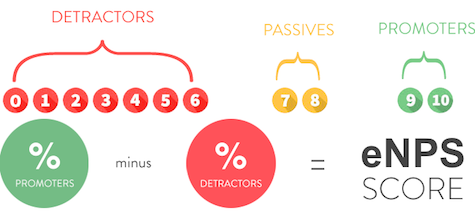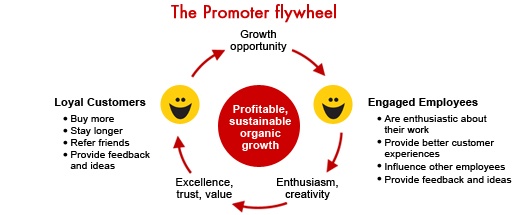What is Employee Net Promoter Score (eNPS)?
Employee Net Promoter Score (eNPS) is a valuable metric that allows organizations to gauge the loyalty and satisfaction levels of their employees. It is derived from the customer loyalty metric, Net Promoter Score (NPS), and is a highly effective tool for measuring and improving employee engagement.
Employee engagement is the cornerstone of any successful organization. An engaged workforce doesn’t just contribute to productivity; it drives innovation, loyalty, and overall business success. A powerful way to measure and improve employee engagement is through the Employee Net Promoter Score (eNPS).

How to Calculate eNPS ⇒
eNPS is a measurement system that assesses how likely employees are to recommend their organization as a place to work. It is based on a simple question: “On a scale of 0 to 10, how likely are you to recommend our company as a place to work?” Employees are categorized into three groups based on their responses:
- Promoters (score 9-10): These employees are highly satisfied and loyal. They actively promote the company as a great place to work.
- Passives (score 7-8): These employees are generally satisfied but not as enthusiastic as promoters. They are less likely to actively promote the company.
- Detractors (score 0-6): These employees are dissatisfied and may actively discourage others from working at the company.
The eNPS is then calculated as the difference between the percentage of promoters and the percentage of detractors.
eNPS = % Promoters – % Detractors
Key Components of eNPS ⇒
In addition to the net score, eNPS takes into account the open-ended feedback provided by employees. These comments offer valuable insights into the reasons behind the given scores. This allows organizations to identify specific areas for improvement and take appropriate action.
The open-ended feedback is a crucial aspect of eNPS as it provides qualitative data that complements the quantitative net score. It allows organizations to understand the underlying factors influencing employee loyalty and satisfaction. By analyzing the feedback, companies can uncover patterns, trends, and recurring themes that can guide their efforts in creating a positive work environment.
Furthermore, the open-ended feedback encourages employees to express their thoughts and concerns openly, fostering a culture of transparency and trust. This can lead to increased employee engagement and a stronger sense of belonging within the organization.
Organizations that effectively leverage the open-ended feedback from eNPS surveys can gain a competitive advantage by addressing specific issues and implementing targeted improvements. By listening to their employees and taking action based on their feedback, companies can create a workplace that attracts and retains top talent.
The Importance of eNPS in Business ⇒
eNPS, or Employee Net Promoter Score, plays a crucial role in driving employee engagement and ultimately impacts an organization’s overall performance. By measuring and improving employee satisfaction levels, eNPS serves as a powerful tool for organizations to enhance their workforce and achieve success.
Role of eNPS in Employee Engagement ⇒
Importance of Engaged Employees
Engaged employees drive organizational success through better performance and retention.
Gaining Insights with eNPS
eNPS measures employee satisfaction, providing insights into workforce sentiment and improvement areas.
Addressing Employee Concerns
Monitoring eNPS helps identify and resolve issues impacting engagement, fostering a supportive culture.
Encouraging Honest Feedback
Anonymity in eNPS encourages candid feedback, revealing true employee sentiments for informed decision-making.
Building Trust and Satisfaction
Addressing concerns builds trust, enhances satisfaction, and creates a positive work environment that boosts productivity.
eNPS and Organizational Performance ⇒
Organizations with higher eNPS typically have a more motivated and productive workforce. Engaged employees are more likely to go the extra mile, resulting in increased customer satisfaction, improved quality of work, and enhanced overall performance.
When employees are engaged and satisfied, they are more likely to deliver exceptional customer service. They understand the importance of their role in the organization’s success and are motivated to provide the best possible experience to customers. This, in turn, leads to higher customer satisfaction levels, increased customer loyalty, and ultimately, business growth.
In addition to customer satisfaction, eNPS also impacts the quality of work produced by employees. Engaged employees are more likely to take pride in their work, pay attention to detail, and strive for excellence. This results in higher-quality products or services, which can give organizations a competitive edge in the market. Highly engaged and satisfied employees results in more loyal customers as shown in the promoter flywheel.
Gallup’s State of the American Workplace, reports that companies in the top quartile of employee engagement have 10% higher customer ratings indicating a connection between employee engagement and customers.
Moreover, organizations with high eNPS tend to have lower employee turnover rates. Engaged employees are more likely to stay with the company for the long term, reducing recruitment and training costs. This stability within the workforce allows organizations to build a strong and cohesive team, leading to improved collaboration and efficiency.
Interpreting the eNPS Results ⇒
Calculating eNPS
eNPS is found by subtracting the percentage of detractors (scores 0-6) from promoters (scores 9-10).
Understanding eNPS Scores
Scores range from -100 to +100; higher scores indicate greater employee loyalty and engagement.
Impact of Positive eNPS
A positive eNPS suggests employees are likely to recommend the company, enhancing recruitment and reputation.
Broader Feedback Strategy
eNPS is one metric among many. Include qualitative feedback and action plans for improvement.
Ongoing Analysis
Regularly measuring eNPS tracks employee sentiment over time, leading to better engagement, productivity, and lower turnover.
Implementing eNPS in Your Organization ⇒
Here’s a streamlined guide to successfully implement the Employee Net Promoter Score (eNPS) in your organization:
Define Your Objectives: Clarify your goals with eNPS, such as improving engagement or gauging employee sentiment.
Choose the Right Timing: Decide on the frequency of surveys and select periods when employees can provide thoughtful feedback.
Craft Your Survey: Use the core eNPS question and include open-ended questions for richer insights.
Ensure Anonymity: Guarantee that responses remain anonymous to encourage candid feedback.
Distribute the Survey: Share the survey via email or internal platforms, and send reminders to boost participation.
Analyze the Results: Calculate the eNPS score and break down the data by team or department.
Communicate Findings: Share the results with employees, emphasizing the overall score and key insights.
Take Action: Address feedback from detractors and develop targeted initiatives for improvement.
Follow Up: Conduct follow-up surveys to assess the effectiveness of changes made.
Cultivate a Feedback Culture: Encourage ongoing input through regular check-ins and open discussions.
Implementing these steps will strengthen employee engagement and contribute to a positive workplace culture.
Common Mistakes to Avoid When Using eNPS ⇒
While eNPS is a powerful tool, it’s important to avoid common pitfalls that can limit its effectiveness. Here are some mistakes to watch out for:
Focusing Solely on the Score
While the eNPS score is important, it’s not the only thing that matters. Focusing solely on improving the score without addressing the underlying issues won’t lead to meaningful change. Pay close attention to the qualitative feedback that accompanies the score to get a more complete picture of employee sentiment.
Ignoring the Passives
It’s easy to focus on promoters and detractors, but don’t overlook the passives. These employees may not be highly engaged, but they also haven’t turned into detractors yet. With the right attention and support, you can move them into the promoter category, improving overall engagement levels.
Failing to Act on Feedback
Employees are more likely to participate in eNPS surveys if they know their feedback will lead to real change. Failing to act on the insights gained from eNPS can lead to disengagement and skepticism about future surveys.
How to Encourage Honest Feedback in eNPS Surveys ⇒
For eNPS to be effective, employees need to feel comfortable providing honest feedback. Here are a few tips to encourage transparency in eNPS surveys:
Ensure Anonymity
One of the most important factors in getting honest feedback is ensuring anonymity. When employees know their responses won’t be traced back to them, they’re more likely to provide candid feedback, both positive and negative.
Communicate the Purpose
Before launching your eNPS survey, communicate the purpose clearly to your employees. Let them know that the goal is to improve the workplace, not to punish individuals for negative feedback. This will encourage more openness in responses.
Follow Through on Feedback
The best way to build trust in the eNPS process is by following through on feedback. If employees see that their feedback leads to positive change, they’ll be more likely to provide honest and meaningful input in future surveys.
The Future of eNPS ⇒
The employee feedback landscape is continually evolving, and eNPS is expected to evolve along with it. Here are a couple of future trends to consider:
Trends in Employee Feedback
Organizations are increasingly leveraging technology to gather real-time employee feedback. Traditional annual or bi-annual surveys are being replaced by continuous feedback systems that provide immediate insights and allow for quicker intervention.
Innovations in eNPS Tools and Techniques
As technology advances, eNPS tools and techniques are becoming more refined. Automated survey platforms like HubEngage are incorporating advanced analytics and predictive capabilities to provide organizations with deeper insights and proactive solutions to improve engagement and drive positive change.
Why eNPS is Essential for Employee Engagement ⇒
Ultimately, eNPS is not just about measuring satisfaction but about creating a culture of continuous improvement. Employees who feel heard, valued, and understood are more likely to stay committed and recommend your company to others, strengthening both retention and recruitment efforts.
HubEngage is not only your tool for implementing eNPS but your partner in driving real, actionable engagement that boosts morale and builds a thriving workplace. Let HubEngage help you take your employee engagement strategy to the next level with the power of eNPS.
To summarize, eNPS is a powerful metric that organizations can use to measure employee loyalty, satisfaction, and engagement. By implementing eNPS and utilizing employee communication and survey platforms like HubEngage, organizations can better understand their employees’ needs and take concrete steps to improve their experience at work. Regular automated recurring surveys can monitor employee NPS and provide valuable insights to drive continuous improvement. Embracing eNPS and utilizing technology to optimize its use will undoubtedly contribute to a thriving and engaged workforce.
See how HubEngage’s survey platform provides a comprehensive set of employee survey tools to measure and track eNPS.















